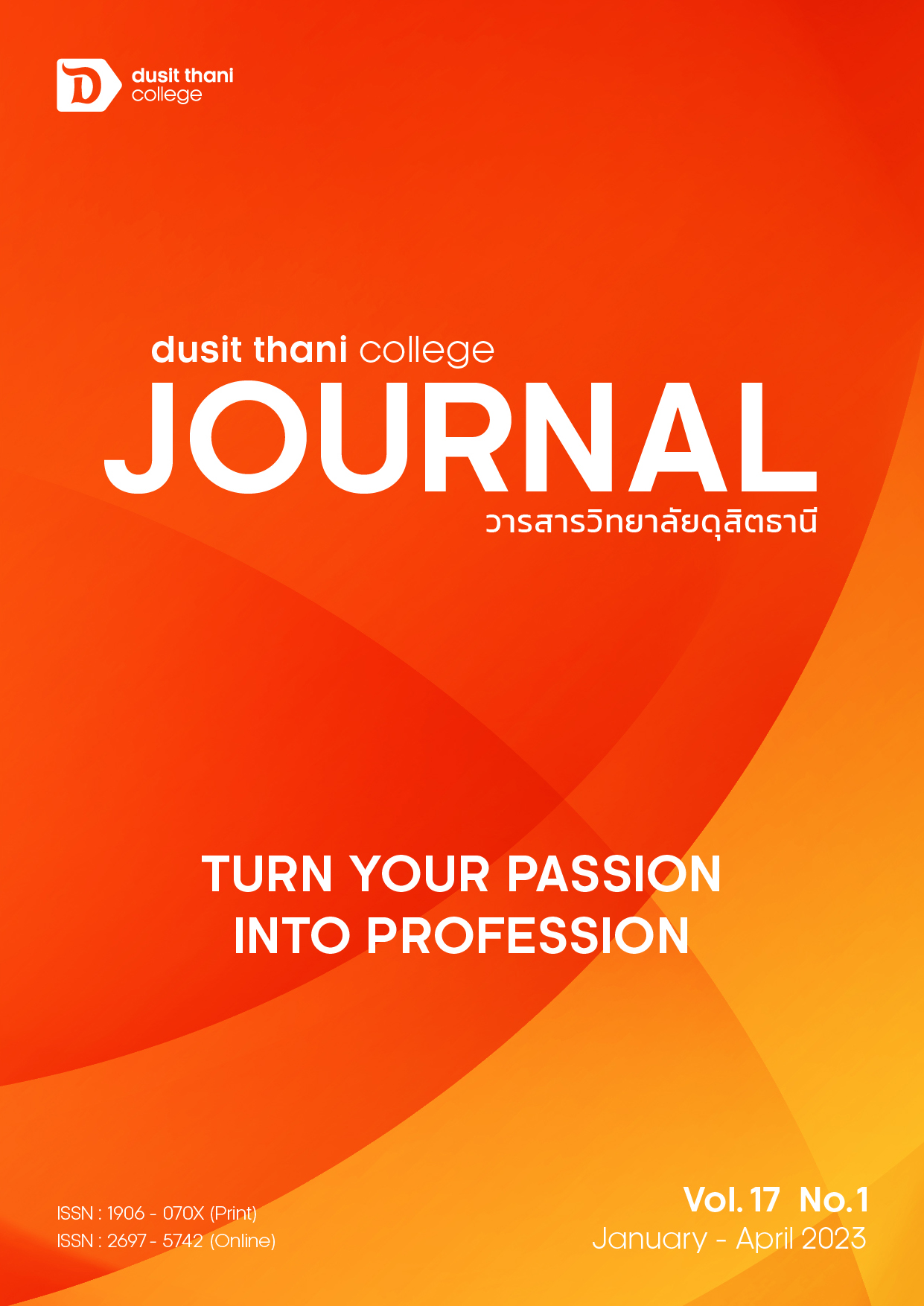การค้นหาองค์ประกอบความเป็นไทยในโรงแรม: กรณีศึกษาโรงแรมระดับห้าดาว
Main Article Content
บทคัดย่อ
หลายทศวรรษที่ผ่านมาประเทศไทยได้ใช้อัตลักษณ์ความเป็นไทยเป็นจุดขายและใช้เป็นส่วนหนึ่งของแคมเปญทางการตลาดเพื่อส่งเสริมการท่องเที่ยวและเพิ่มประสบการณ์ที่ดีให้กับผู้รับบริการ งานวิจัยนี้มีวัตถุประสงค์ 1) เพื่อศึกษาองค์ประกอบของความเป็นไทยในมุมมองของผู้รับบริการในโรงแรมระดับ
5 ดาว และ 2) เพื่อศึกษาเอกลักษณ์และความโดดเด่นด้านความเป็นไทยในโรงแรมระดับ 5 ดาว งานวิจัยนี้เป็นงานวิจัยเชิงคุณภาพโดยมีการเก็บข้อมูลจากการสัมภาษณ์จากพนักงานโรงแรมระดับ 5 ดาว จำนวน 5 ท่าน และเก็บข้อมูลจากรีวิวของผู้รับบริการที่ใช้บริการในโรงแรมที่ได้รับรางวัลที่เกี่ยวเนื่องกับความเป็นไทย หรือเป็นโรงแรมที่มีองค์ประกอบความเป็นไทยอย่างชัดเจน จำนวน 95 รีวิว โดยใช้วิธีวิจัยชาติพันธุ์วรรณนาทางอินเทอร์เน็ต (Netnography) ผลจากการศึกษาพบว่าความเป็นไทยมีองค์ประกอบหลัก 4 ด้านซึ่งประกอบด้วย มารยาท บรรยากาศ อาหารไทย และ วัฒนธรรมไทย ล้วนเป็นองค์ประกอบสำคัญของความเป็นไทยที่สำคัญที่ถูกนำมาใช้ในอุตสาหกรรมโรงแรม นอกจากนี้ผลการวิจัยพบว่าในมุมมองของผู้รับบริการและผู้ให้บริการ กิริยาและมารยาทของพนักงานเป็นสิ่งที่สำคัญที่สุด เพราะเป็นสิ่งที่บ่งชี้ความเป็นไทยได้ชัดเจนที่สุด
Article Details

อนุญาตภายใต้เงื่อนไข Creative Commons Attribution-NonCommercial-NoDerivatives 4.0 International License.
นโยบายการพิจารณากลั่นกรองบทความ
- บทความวิจัยและบทความวิชาการทุกเรื่องที่จะได้รับการตีพิมพ์ต้องผ่านการพิจารณากลั่นกรองโดยผู้ทรงคุณวุฒิ (Peer Review) ในสาขาที่เกี่ยวข้อง จำนวน 3 ท่าน/บทความ
- บทความ ข้อความ ภาพประกอบและตารางประกอบที่ลงตีพิมพ์ในวารสารเป็นความคิดเห็นส่วนตัวของผู้เขียน กองบรรณาธิการไม่จำเป็นต้องเห็นด้วยเสมอไป และไม่มีส่วนรับผิดชอบใด ๆ ถือเป็นความรับผิดชอบของผู้เขียนแต่เพียงผู้เดียว
- บทความที่จะได้รับการตีพิมพ์จะต้องไม่เคยตีพิมพ์ เผยแพร่ที่ใดมาก่อน และไม่อยู่ระหว่างการพิจารณาของวารสารฉบับอื่น หากตรวจสอบพบว่ามีการตีพิมพ์ซ้ำซ้อน ถือเป็นความรับผิดชอบของผู้เขียนแต่เพียงผู้เดียว
- บทความใดที่ผู้อ่านเห็นว่าได้มีการลอกเลียนหรือแอบอ้างโดยปราศจากการอ้างอิง หรือทำให้เข้าใจผิดว่าเป็นผลงานของผู้เขียน กรุณาแจ้งให้กองบรรณาธิการวารสารทราบจะเป็นพระคุณยิ่ง
เอกสารอ้างอิง
Alnawas, I. and Altarifi, S. (2015). Exploring the role of brand identification and brand love in generating higher levels of brand loyalty. Journal of Vacation Marketing, 22(2), 111–128. https://doi.org/10.1177/1356766715604663
Berry, L. L., Wall, E. A., and Carbone, L. P. (2006). Service Clues and Customer Assessment of the Service Experience: Lessons from Marketing. Academy of Management Perspectives, 20(2), 43–57. https://doi.org/10.5465/amp.2006.20591004
DAM, S. M. and DAM, T. C. (2021). Relationships between Service Quality, Brand Image, Customer Satisfaction, and Customer Loyalty. The Journal of Asian Finance, Economics and Business, 8(3), 585–593. https://doi.org/10.13106/
JAFEB.2021.VOL8.NO3.0585
Fakfare, P., Talawanich, S., Pongwat, A., and Chon, K. (2019). Asianness in Hospitality: The Case of Luxury Hotels in Bangkok, Thailand. ASEAN Journal of Management and Innovation, 6(2), 77–92. https://doi.org/10.14456/ajmi.2019.22
Femenia-Serra, F., Gretzel U., and Alzua-Sorzabal, A. (2022). Instagram travel influencers in #quarantine: Communicative practices and roles during COVID-19, Tourism Management https://doi.org/10.1016/j.tourman.2021.104454
Fida, B. A., Ahmed, U., Al-Balushi, Y., and Singh, D. (2020). Impact of Service Quality on Customer Loyalty and Customer Satisfaction in Islamic Banks in the Sultanate of Oman. SAGE Open, 10(2), 215824402091951. https://doi.org/10.1177/
Filieri, R., Alguezaui, S., and McLeay, F. (2015). Why do travelers trust TripAdvisor? Antecedents of trust towards consumer-generated media and its influence on recommendation adoption and word of mouth. Tourism Management, 51, 174–185. https://doi.org/10.1016/j.tourman.2015.05.007
Jang, S., Liu, T., Kang, J. H., and Yang, H. (2018). Understanding Important Hotel Attributes from the Consumer Perspective over Time. Australasian Marketing Journal, 26(1), 23–30. https://doi.org/10.1016/j.ausmj.2018.02.001
Järvi, H., Keränen, J., Ritala, P., and Vilko, J. (2020). Value co-destruction in hotel services: Exploring the misalignment of cognitive scripts among customers and providers. Tourism Management, 77, 1–11. https://doi.org/10.1016/j.tourman.2019.104030
Kongpolphrom, W. (2018). Thainess realisation in selected travel websites. Thai Interdisciplinary Research, 13(4), 63–67. https://doi.org/10.14456/jtir.2018.42
Kozinets, R. V. (2002). The Field behind the Screen: Using Netnography for Marketing Research in Online Communities. Journal of Marketing Research, 39(1), 61–72. https://doi.org/10.1509/jmkr.39.1.61.18935
Mouzaek, E., Marzouqi, A. A., Alaali, N., Salloum, S. A., Aburayya, A., and Suson, R. (2021). An Empirical Investigation of the Impact of Service Quality Dimensions on Guests Satisfaction: A Case Study of Dubai Hotels. Journal of Contemporary Issues in Business and Government, 27(3). https://doi.org/10.47750/cibg.2021.27.03.160
Najpinij, N. (2012). Constructing “Thainess” in Thai Gastronomy in Five-Star Hotels in Bangkok: Case Studies of Nahm and Sala Rim Naam. Rian Thai: International Journal of Thai Studies, 5(2012), 153-177.
Nandan, S. (2005). An exploration of the brand identity–brand image linkage: A communications perspective. Journal of Brand Management, 12(4), 264–278. https://doi.org/10.1057/palgrave.bm.2540222
Nangklaphivat, Y. (2017). Services with Thainess in Hotel and Tourism Business. EAU HERITAGE JOURNAL, 7 (1), 52-60.
Narangajavana, Y. and Hu, B. (2008). The Relationship Between the Hotel Rating System, Service Quality Improvement, and Hotel Performance Changes: A Canonical Analysis of Hotels in Thailand. Journal of Quality Assurance in Hospitality & Tourism, 9(1), 34–56. https://doi.org/10.1080/15280080802108259
Stefano, N., Filho, N. C., Barichello, R., and Sohn, A. (2015). A Fuzzy SERVQUAL Based Method for Evaluated of Service Quality in the Hotel Industry. Procedia CIRP, 30, 433–438. https://doi.org/10.1016/j.procir.2015.02.140
Suksutdhi, T. and Boonyanmethaporn, W. (2022). AN EXPLORATORY FACTOR ANALYSIS OF THAINESS EXPERIENCE-CENTRIC SERVICE CONSTRUCTION FOR BOUTIQUE HOTEL GUESTS. GeoJournal of Tourism and Geosites, 40(1), 96-103. https://doi.org/10.30892/gtg.40111-807
Sürücü, Z., Öztürk, Y., Okumus, F., and Bilgihan, A. (2019). Brand awareness, image, physical quality and employee behavior as building blocks of customer-based brand equity: Consequences in the hotel context. Journal of Hospitality and Tourism Management, 40, 114–124. https://doi.org/10.1016/j.jhtm.2019.07.002
Tan, E., Cherapanukorn, V., Kim, H. H., and Chon, K. (2014). The Art of Service in Asia: A Conceptual Framework through a Case Study of Hospitality Industry in Thailand. In Proceedings of the Global Tourism and Hospitality Conference and 11th Asia Tourism Forum, 1217–1244.
TAT Newsroom. (2022, May 8). Thailand rated among world’s top post-pandemic destinations. TAT Newsroom. Retrieved October 4, 2022, from https://www.tatnews.org/2022/05/thailand-rated-among-worlds-top-post-pandemic-destinations/
Thailand Tourism Statistics. Tourist Arrivals from 2000 till 2022. Influence of Epidemics (including Covid-19), Political Events (Military Coup), Floods and Environmental Factors, Economic Downturn. (n.d.). Retrieved October 4, 2022, from https://www.thaiwebsites.com/tourism.asp
Thanaphatteeranan, T. (2019, August 7). DSpace at Silpakorn University: Thainess Hospitality Design for Hotel in Koh Samui, Suratthani Province. Retrieved September 24, 2022, from http://ithesis-ir.su.ac.th/dspace/handle/123456789/2130
Wall, E. A. and Berry, L. L. (2007). The Combined Effects of the Physical Environment and Employee Behavior on Customer Perception of Restaurant Service Quality. Cornell Hotel and Restaurant Administration Quarterly, 48(1), 59–69.


